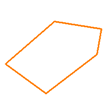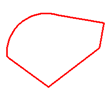Today, my group mates and I visited Singapore Art Museum for our group assignment. It was a fruitful trip as I saw quite a number of abstract Art pieces at the galleries. Hmmmm....i was wondering, how did these artists come up with such ideas and transfer them into their artworks.
After returning to our class, Dr. Yeap told us to use tangrams to form squares. So what is tangrams?
This is what I have searched.....
The tangram is among the most popular of all dissection puzzles that exist today. A tangram is an ancient, unique, Chinese puzzle that consists of seven (geometric) pieces: one square, five triangles and one parallelogram. When all pieces are put together, they form one big square, when they are sperated, they form what is called a tan. Of the five triangles there are two large, two small and one medium in size. "The large triangle is twice the area of the medium triangle. The medium triangle, the square, and the parallelogram are each twice the area of the small triangle. Each angle of the square measures 90 degrees. Each triangle contains a 90 degree and two 45 degree angles, which makes them isosceles right triangles. The parallelogram contains 45 degree and 135 degree angles" (Bohning, G., et al., 1997, p. 3).
The relationship among the pieces enables them to fit together to form many figures and arrangements. However, the tangram is more than a seven piece square. When it comes to tangrams, the challenge is to arrange the pieces to form additional shapes. The seven pieces can be arranged to make anything form a rabbit, to the alphabet, to a person. "The tangram is the opposite of a jigsaw puzzle. Instead of fitting the pieces together in only one way, the seven tangram pieces can be arranged to make a great number of different figures" (Bohning, G., et al., 1997, p. 4).
My groupmates and I have formed different sizes of squares using tangrams:
After the tangram activities, we were introduced to "BODMAS"...Have you heard of it?
If you've not heard about it, please read the text below:
Order of Operations - BODMAS
Operations
"Operations" mean things like add, subtract, multiply, divide, squaring, etc. If it isn't a number it is probably an operation.
But, when you see something like...
7 + (6 × 52 + 3)
... what part should you calculate first?
Start at the left and go to the right?
Or go from right to left?
Calculate them in the wrong order, and you will get a wrong answer !
So, long ago people agreed to follow rules when doing calculations, and they are:
Order of Operations
Do things in Brackets First. Example:
 | | 6 × (5 + 3) | = | 6 × 8 | = |
48
| |
 | | 6 × (5 + 3) | = | 30 + 3 | = |
33
| (wrong) |
Exponents (Powers, Roots) before Multiply, Divide, Add or Subtract. Example:
 | | 5 × 22 | = | 5 × 4 | = |
20
| |
 | | 5 × 22 | = | 102 | = |
100
| (wrong) |
Multiply or Divide before you Add or Subtract. Example:
 | | 2 + 5 × 3 | = | 2 + 15 | = |
17
| |
 | | 2 + 5 × 3 | = | 7 × 3 | = |
21
| (wrong) |
Otherwise just go left to right. Example:
 | | 30 ÷ 5 × 3 | = | 6 × 3 | = |
18
| |
 | | 30 ÷ 5 × 3 | = | 30 ÷ 15 | = |
2
| (wrong) |
How Do I Remember It All ... ? BODMAS !
| |
B
| Brackets first |
O
| Orders (ie Powers and Square Roots, etc.) |
DM
| Division and Multiplication (left-to-right) |
AS
| Addition and Subtraction (left-to-right) |
Divide and Multiply rank equally (and go left to right).
Add and Subtract rank equally (and go left to right)
 | | After you have done "B" and "O", just go from left to right doing any "D" or "M" as you find them.
Then go from left to right doing any "A" or "S" as you find them. |
Here are some BODMAS questions for you to answer, enjoy......
Question 1
What is the value of 3 + 6 ÷ 3 × 2 ?
A 7 B 6 C 4 D 1.5
Question 2
What is the value of 5 × 3 - 12 ÷ 4 + 8
Question 3
What is the value of 5 × 4 - 2 × 3 + 16 ÷ 4
A 10 B 11½ C 18 D 34














